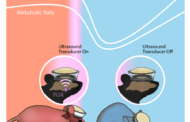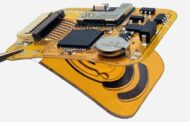
via Caltech
Brain–machine interfaces (BMIs) are devices that can read brain activity and translate that activity to control an electronic device like a prosthetic arm or computer cursor. They promise to enable people with paralysis to move prosthetic devices with their thoughts.
Many BMIs require invasive surgeries to implant electrodes into the brain in order to read neural activity. However, in 2021, Caltech researchers developed a way to read brain activity using functional ultrasound (fUS), a much less invasive technique.
Now, a new study is a proof-of-concept that fUS technology can be the basis for an “online” BMI—one that reads brain activity, deciphers its meaning with decoders programmed with machine learning, and consequently controls a computer that can accurately predict movement with very minimal delay time.
The study was conducted in the Caltech laboratories of Richard Andersen, James G. Boswell Professor of Neuroscience and director and leadership chair of the T&C Chen Brain–Machine Interface Center; and Mikhail Shapiro, Max Delbrück Professor of Chemical Engineering and Medical Engineering and Howard Hughes Medical Institute Investigator. The work was a collaboration with the laboratory of Mickael Tanter, director of physics for medicine at INSERM in Paris, France.
“Functional ultrasound is a completely new modality to add to the toolbox of brain–machine interfaces that can assist people with paralysis,” says Andersen. “It offers attractive options of being less invasive than brain implants and does not require constant recalibration. This technology was developed as a truly collaborative effort that could not be accomplished by one lab alone.”
“In general, all tools for measuring brain activity have benefits and drawbacks,” says Sumner Norman, former senior postdoctoral scholar research associate at Caltech and a co-first author on the study. “While electrodes can very precisely measure the activity of single neurons, they require implantation into the brain itself and are difficult to scale to more than a few small brain regions. Non-invasive techniques also come with tradeoffs. Functional magnetic resonance imaging [fMRI] provides whole-brain access but is restricted by limited sensitivity and resolution. Portable methods, like electroencephalography [EEG] are hampered by poor signal quality and an inability to localize deep brain function.”
Ultrasound imaging works by emitting pulses of high frequency sound and measuring how those sound vibrations echo throughout a substance, such as various tissues of the human body. Sound waves travel at different speeds through these tissue types and reflect at the boundaries between them. This technique is commonly used to take images of a fetus in utero, and for other diagnostic imaging.
Because the skull itself is not permeable to sound waves, using ultrasound for brain imaging requires a transparent “window” to be installed into the skull. “Importantly, ultrasound technology does not need to be implanted into the brain itself,” says Whitney Griggs (PhD ’23), a co-first author on the study. “This significantly reduces the chance for infection and leaves the brain tissue and its protective dura perfectly intact.”
“As neurons’ activity changes, so does their use of metabolic resources like oxygen,” says Norman. “Those resources are resupplied through the blood stream, which is the key to functional ultrasound.” In this study, the researchers used ultrasound to measure changes in blood flow to specific brain regions. In the same way that the sound of an ambulance siren changes in pitch as it moves closer and then farther away from you, red blood cells will increase the pitch of the reflected ultrasound waves as they approach the source and decrease the pitch as they flow away. Measuring this Doppler-effect phenomenon allowed the researchers to record tiny changes in the brain’s blood flow down to spatial regions just 100 micrometers wide, about the width of a human hair. This enabled them to simultaneously measure the activity of tiny neural populations, some as small as just 60 neurons, widely throughout the brain.
The researchers used functional ultrasound to measure brain activity from the posterior parietal cortex (PPC) of non-human primates, a region that governs the planning of movements and contributes to their execution. The region has been studied by the Andersen lab for decades using other techniques. The animals were taught two tasks, requiring them to either plan to move their hand to direct a cursor on a screen, or plan to move their eyes to look at a specific part of the screen. They only needed to think about performing the task, not actually move their eyes or hands, as the BMI read the planning activity in their PPC.
“I remember how impressive it was when this kind of predictive decoding worked with electrodes two decades ago, and it’s amazing now to see it work with a much less invasive method like ultrasound,” says Shapiro.
The ultrasound data was sent in real-time to a decoder (previously trained to decode the meaning of that data using machine learning), and subsequently generated control signals to move a cursor to where the animal intended it to go. The BMI was able to successfully do this to eight radial targets with mean errors of less than 40 degrees.
“It’s significant that the technique does not require the BMI to be recalibrated each day, unlike other BMIs,” says Griggs. “As an analogy, imagine needing to recalibrate your computer mouse for up to 15 minutes each day before use.”
Next, the team plans to study how BMIs based on ultrasound technology perform in humans, and to further develop the fUS technology to enable three-dimensional imaging for improved accuracy.
Original Article: Ultrasound Enables Less-Invasive Brain–Machine Interfaces
More from: California Institute of Technology | Howard Hughes Medical Institute | INSERM
The Latest Updates from Bing News
Go deeper with Bing News on:
Brain-machine interface
- How Effective Is Neuralink’s Blindsight Likely To Be? Scientists Speak On Potential Health Impacts
This week, in ABP Live's science column, we explain how effective Blindsight, the latest endeavour by Elon Musk’s neurotechnology firm Neuralink, is likely to be.
- China eyes advancing brain-machine interface technology at 2024 ZGC Forum
Officials, scholars, and business representatives agreed to further promote the development of the brain-machine interface (BMI) technology and fully tap into the broad opportunities of frontier ...
- China's homegrown brain-machine interface system unveiled at Zhongguancun Forum
This photo shows the NeuCyber Array BMI System, a self-developed brain-machine interface (BMI) system from China, unveiled at the opening ceremony of the 2024 Zhongguancun Forum in Beijing, capital of ...
- Hybrid brain lets one species' neurons help out another's
Adding rat stem cells to a mouse embryo resulted in a ‘hybrid brain’ in which the rat cells stepped in to restore function when the mouse’s sense of smell was removed, new research has shown. It’s the ...
- Brain Computer Interface Market Deciphering Consumer Decision-Making the Role of Ethnography Techniques
Request To Download Free Sample of This Strategic Report @- Brain Computer Interface Market is valued approximately at USD $ billion in 2019 and is anticipated to grow with a healthy growth rate of ...
Go deeper with Bing News on:
Ultrasound brain-machine interface
- Accuvix A30 Ultrasound Machine from Samsung
a sensitive interface and a forward-looking ergonomic design. With the release of the world's first 21.5-inch HD LED ultrasound monitor, the Accuvix A30 introduces high resolution image ...
- Brain–machine interface articles from across Nature Portfolio
Use of a robotic balance simulator demonstrates that humans can learn to balance with long sensorimotor delays in different contexts (movement direction, muscle effectors) and generalize learned ...
- New brain-computer interface lets users game with their minds
Every brain is unique, just like a fingerprint. Traditional brain-computer interfaces require extensive calibration for each individual user. This involves a lengthy process of mapping brain activity ...
- Focused ultrasound technique gets quality assurance protocol
More information: Chih-Yen Chien et al, Quality assurance for focused ultrasound-induced blood-brain barrier opening procedure using passive acoustic detection, eBioMedicine (2024). DOI: 10.1016/j ...
- Can brain ultrasound treat addiction? A cocaine study may hold answers.
The treatment is low-intensity focused ultrasound or LIFU ... in a functional MRI (fMRI) machine — which measures changes in blood flow throughout the brain, indicating brain activity ...







